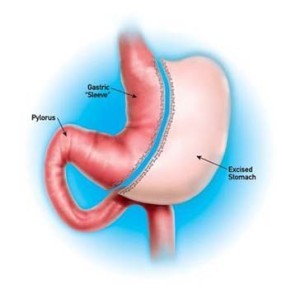Post updated November 2020.
In 2010 <10% of weight loss operations were sleeve gastrectomy operations. In just three short years, the sleeve went from a distant third place in popularity, significantly behind both the gastric bypass and LAP-BAND®, to first place. It has remained in first place ever since.
This fast rise in popularity suggests that the sleeve gastrectomy operation has significant advantages over the alternative operations, the gastric bypass and gastric banding. In my opinion the advantages of sleeve gastrectomy are as follows:
-
- Excellent weight loss outcomes, similar to gastric bypass
- Less long-term risk than with gastric bypass or gastric banding
- A more normal postoperative eating experience
I will discuss each of these advantages in more detail, but first let’s review the sleeve gastrectomy – what it is and how it works.
About Sleeve Gastrectomy
The sleeve gastrectomy operation involves laparoscopically reducing the size of the stomach from approximately 30-40 ounces in volume to approximately 3-4 ounces in volume. This is done by dividing across the stomach like shown in the diagram, and removing the large excluded portion of the stomach.
The sleeve volume is made to be overly small initially, because over time the sleeve will expand. Studies show that the stomach will approximately double in volume over time, so a 3-4 ounce sleeve will eventually become approximately 6-8 ounces in volume.
A couple important points to make about the sleeve that will be important to the discussion below: 1) the stomach pouch is large (3-4 ounces) compared to the gastric bypass pouch (1-2 ounce) and LAP-BAND® pouch (1/2 ounce), and 2) stomach emptying occurs through the normal muscular sphincter at the bottom of the stomach rather than through the very small fixed diameter openings at the bottom of the gastric bypass and LAP-BAND® stomach pouches.
Excellent Weight Loss
Average weight loss after sleeve gastrectomy is typically reported to be about 60-70% of excess weight. This is similar to the average weight loss after gastric bypass, and significantly better than the average weight loss after the LAP-BAND®. Disclaimer – individual patient results vary.
To visualize what 70% of excess weight loss looks like, see photos below:
This patient lost 90 pounds after sleeve gastrectomy, which was 73% of her excess weight. This outcome is a typical weight loss outcome after sleeve gastrectomy. Disclaimer – individual patient results vary.
The sleeve gastrectomy causes weight loss by doing two things.
First, the small stomach restricts food intake by causing more satiety with less food.
Second, the operation changes how the biology that regulates body weight works. Normally, the body will react to weight loss by increasing hunger and cravings, and decreasing metabolic rate to cause weight regain back up to the “set point” weight. The sleeve gastrectomy (like the gastric bypass) changes this biology, resulting in the body accepting a new lower weight as the set point. This is what gives patients the ability to maintain weight loss long-term.
To learn more read Dr. Oliak’s blog post Weight Loss Surgery Changes The Body Weight Set Point.
Less Long-Term Risk
The sleeve gastrectomy is associated with fewer long-term potential complications than the gastric bypass and the LAP-BAND®.
The reason for this is because GI tract anatomy remains more normal. The stomach is made to be substantially smaller, but food travels through the GI tract normally, and there is not an implanted foreign body.
The main long-term potential complication that has been reported after the sleeve gastrectomy is heartburn/reflux (gerd), which has been reported to occur in approximately 10% of patients. In most sleeve gastrectomy patients with gerd, symptoms can be controlled with antacid medications.
A More Normal Eating Experience
Although individual patient results vary, the sleeve gastrectomy operation typically preserves a more normal eating experience than the gastric bypass or gastric banding. A more normal eating experience, in turn, makes the sleeve gastrectomy an easier operation to live with.
The reason for this is because stomach anatomy and function remain more normal.
Sleeve gastrectomy stomach size, while much smaller than the normal stomach, is substantially larger than the gastric bypass and gastric banding stomach pouches. Because of this the sleeve gastrectomy stomach functions more like a reservoir for food than the bypass or band stomach pouch.
Stomach emptying remains more normal with the sleeve gastrectomy because emptying occurs through the pylorus, the muscle at the bottom of the stomach that controls stomach filling and emptying. Stomach pouch emptying with the bypass and band occurs not through the pylorus but through a very small fixed diameter opening.
These two factors – a larger stomach pouch, and emptying through the normal pylorus – result in a more normal eating experience. How you are able to eat, what you are able to eat, and how you feel when you eat all tend to be less altered with the sleeve than with the bypass or band.
Conclusion
The sleeve gastrectomy has become the favorite weight loss operation in the United States, and has remained the favorite, for good reasons. Weight loss outcomes are typically excellent, long-term risk is low, and it is an easy operation to live with.
Read more about Dr. Oliak and his Orange County weight loss surgery program at www.OliakCenter.com.
More Weight Loss Surgery Resources

David Oliak, M.D.
Dr. Oliak is a board-certified, fellowship-trained surgeon who specializes in minimally invasive (laparoscopic and robotic) weight loss surgery. He has been in practice in Orange County, California, since 2002, has completed more than 3000 weight loss operations, and has a track record of excellent patient outcomes.*
Dr. David Oliak is the founder of the Oliak Center for Weight Loss. He started the Oliak Center because he wanted to provide weight loss surgery done right. His commitment has always been to provide the kind of care that he himself would want to receive. Dr. Oliak is affiliated with only the best bariatric hospitals and surgery centers in Los Angeles County and Orange County.
* Individual patient results vary. Past performance is not a guarantee of future results.
Which weight loss surgeon is right for you?
Download this guide of questions to ask your weight loss surgeon to help make the best decision for you.





